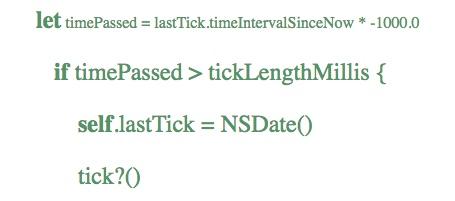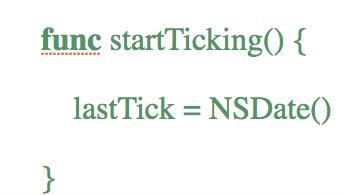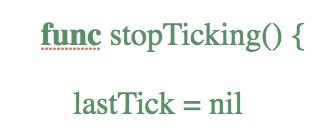-
Game Pieces will need to drop themselves down the gameboard.
A class which extends SKScene inherits the update(currentTime: CFTimeInterval) function. iOS invokes update every frame. A frame is a single image presented to the user. Smooth-running games have higher frame rates; about 60 frames per second or more. Slower games typically plummet below a dismal 30 fps.
A game looks slow when our eyes begin to perceive each individual frame; this is because of discrete motion.
GameScene.swift file, add the follow GREEN code to the update method to discover if a time interval has passed:
import SpriteKit
// #1
let TickLengthLevelOne = NSTimeInterval(600)
class GameScene: SKScene {
// #2
var tick:(() -> ())?
var tickLengthMillis = TickLengthLevelOne

override init(size: CGSize) {
super.init(size: size)
anchorPoint = CGPoint(x: 0, y: 1.0)
let background = SKSpriteNode(imageNamed: "background")
background.position = CGPoint(x: 0, y: 0)
background.anchorPoint = CGPoint(x: 0, y: 1.0)
addChild(background)
}
override func update(currentTime: CFTimeInterval) {
/* Called before rendering each frame */
// #3


}
}
required init(coder aDecoder: NSCoder) {fatalError("NSCoder not supported")
}
// #4


}
}
EXPLINATION:First, we define a new constant at #1, TickLengthLevelOne. This variable will represent the slowest speed at which our shapes will travel. We've set it to 600 milliseconds, which means that every 6/10ths of a second, our shape should descend by one row.
At #2 you can see we've defined some variables. tickLengthMillis and lastTick look like declarations we've seen before: one being the GameScene's current tick length, set to TickLengthLevelOne by default, and the other will track the last time we experienced a tick, an NSDate object.
tick:(() -> ())? looks horrifying… tick is what's known as a closure in Swift. A closure is essentially a block of code that performs a function, and Swift refers to functions as closures. In defining tick, its type is (() -> ())? which means that it's a closure which takes no parameters and returns nothing. Its question mark indicates that it's optional and may be nil.
At #3 we'll put our new member variables to work. Swift's guard statement checks the conditions which follow it, let lastTick = lastTick in our case. If the conditions fail, guard executes the else block. If lastTick is missing, the game is in a paused state and not reporting elapsed ticks, so we return.
But if lastTick is present, we recover the time passed since the last execution of update by invoking timeIntervalSinceNow on our lastTick object. We multiply the result by -1000 to calculate a positive millisecond value. We invoke functions on objects using dot syntax in Swift.
We then check if the time passed has exceeded our tickLengthMillis variable. If enough time has elapsed, we must report a tick. We do so by first updating our last known tick time to the present and then invoking our closure.
By placing a ? after the variable name, we are asking Swift to first check if tick exists and if so, invoke it with no parameters. It's shorthand for the following statements:
if tick != nil {
tick!()
}
Lastly, at #4 we provide accessor methods to let external classes stop and start the ticking process, something we'll make use of later to keep pieces from falling at key moments.

